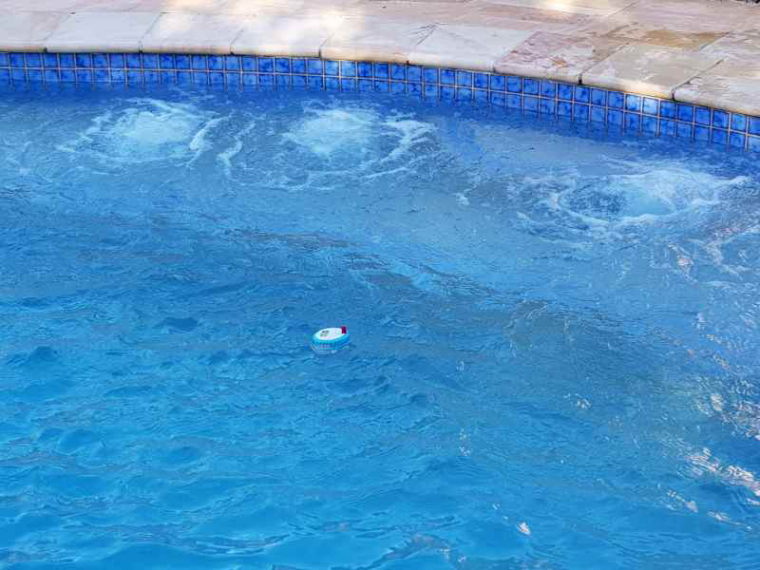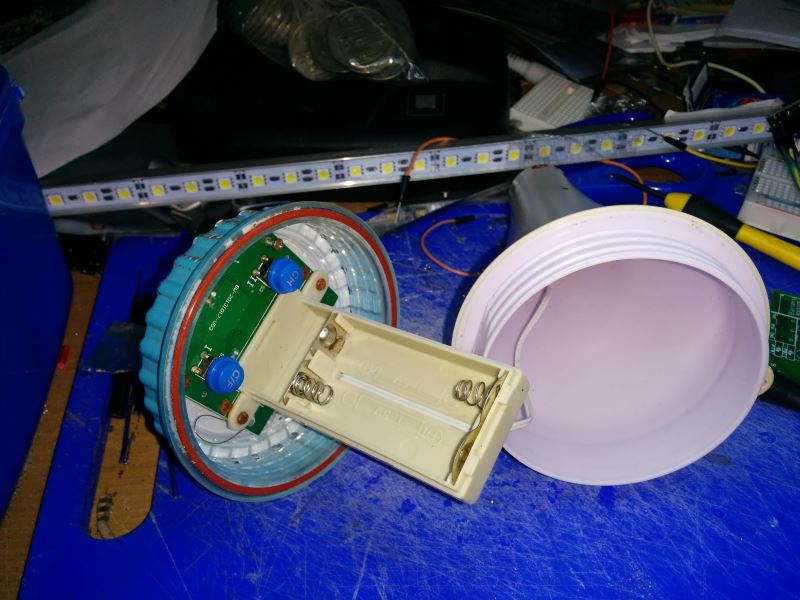Swimming Pool Thermometer
-
Why put the pro mini on the booster? The pro mini should run down to 1.8v, so you should be able to tap that directly off of the battery. The only thing that may require the boost voltage would be the TMP36 which has a minimum of 2.7v. I would figure the less you pull from the boost converter the better. If noise becomes an issue, you could switch your battery pack from a 2xAA pack to a 3xAA pack and do something like this and use the 4.5v for the TMP36 and/or the pro mini and everything else off of the 3v leg.

Nice project though
-
Nice project! I did one also with the same original thermometer. A couple of differences with mine:
- I used a DS18B20 which can run at a much lower voltage, so my batteries can get to about 2.0v before problems happen.
- No boost converter, everything runs straight of 2 batteries so the part count is less as well as avoiding losses in the converter.
- Battery voltage measurement is via the Vcc library which uses no external connections to the arduino, but is accurate enough for this use case.
In the past 5 months my battery voltage has stayed at around 2.97v.
-
Nice project! I did one also with the same original thermometer. A couple of differences with mine:
- I used a DS18B20 which can run at a much lower voltage, so my batteries can get to about 2.0v before problems happen.
- No boost converter, everything runs straight of 2 batteries so the part count is less as well as avoiding losses in the converter.
- Battery voltage measurement is via the Vcc library which uses no external connections to the arduino, but is accurate enough for this use case.
In the past 5 months my battery voltage has stayed at around 2.97v.
@buxtronix Did you do a write up for that project, i would be keen to see your setup and sketch etc.
I had a couple of DS18B20 here also but thought they may draw a little too much, clearly they are working for you though... well done@dbemowsk thanks for your information, I was unaware the pro mini could go down to 1.8v without modifying the clock speed and fuses, I have not done any real investigation into battery powering as until recently nearly all my nodes have been powered by our house solar installation.
At the moment this temp node is functioning well (all be it not in the pool yet) so unless it is a battery chewer I am happy with it to stay as is.
It is now in a different room to the kitchen temp sensor but you can see it is still tracking quite well.

-
@Boots33 I haven't done a writeup of mine, perhaps I should fish it out of the pool sometime and get some photos.
The DS18B20 has a tiny standby current, something like 750nA. Even with 30 second poll intervals, I'm finding my sensors typically get near-shelf life from the batteries.
The physical setup is pretty basic - just a Pro Mini, battery, radio, and ds18b20. There's no circuitry for regulators, dc convertors or battery sensing. Of course I did remove the onboard regulator as it will draw power from the 'out' pin.
One thing I had to do was reprogram the fuses - you may find the Pro Mini comes with the BoD fuses set to like 2.7v. You can set it down to 1.8v so you'll get much longer life out of it. The effort is worth avoiding the hassle of more frequent battery changes.
Battery level sensing uses this VCC library: https://github.com/Yveaux/Arduino_Vcc
-
@buxtronix Did you do a write up for that project, i would be keen to see your setup and sketch etc.
I had a couple of DS18B20 here also but thought they may draw a little too much, clearly they are working for you though... well done@dbemowsk thanks for your information, I was unaware the pro mini could go down to 1.8v without modifying the clock speed and fuses, I have not done any real investigation into battery powering as until recently nearly all my nodes have been powered by our house solar installation.
At the moment this temp node is functioning well (all be it not in the pool yet) so unless it is a battery chewer I am happy with it to stay as is.
It is now in a different room to the kitchen temp sensor but you can see it is still tracking quite well.

@Boots33 - if you are using the EasyPCB this as @buxtronix mentioned are described under "Battery without step up booster (advanced users)" so you can do this with your current hardware as well.
-
@Boots33 - if you are using the EasyPCB this as @buxtronix mentioned are described under "Battery without step up booster (advanced users)" so you can do this with your current hardware as well.
Thanks @sundberg84 I will have a look and learn some more 😊
-
I now have a repeater in range of the pool area so the temperature node is finally transmitting data back to Domoticz.
Here it is lounging about the pool, it sits nice and level and is still afloat after a couple of days in the water.

Pool temp is is nice and comfy at the moment

-
I now have a repeater in range of the pool area so the temperature node is finally transmitting data back to Domoticz.
Here it is lounging about the pool, it sits nice and level and is still afloat after a couple of days in the water.

Pool temp is is nice and comfy at the moment

-
@boots33 That looks refreshing. Currently the outside temp here is 21°F/-6°C with snow on the ground. The cold weather here has only been around for a short time and already I want it to go away.





